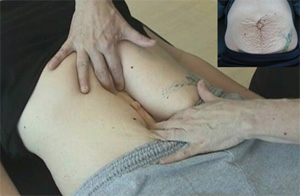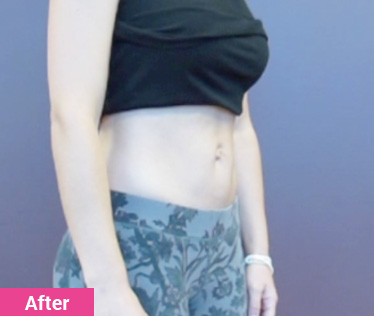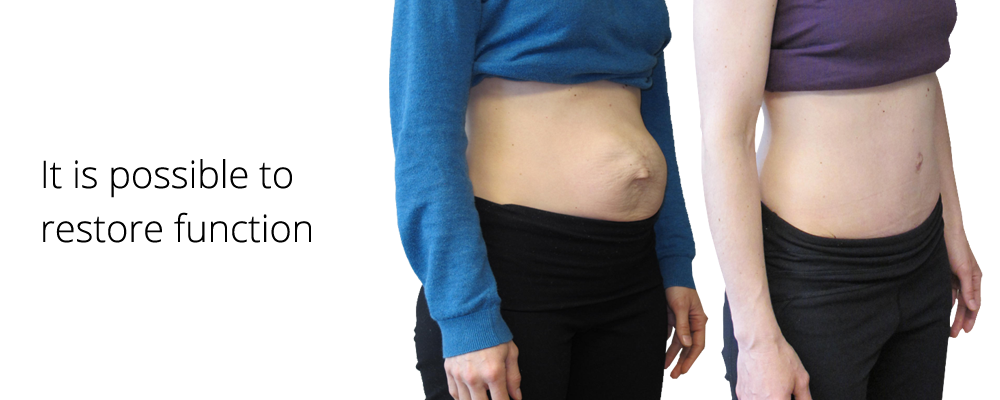

By Diane Lee:
Diastasis Rectus Abdominis:
A Clinical Guide for Those Who Are Split Down the Middle
Learn More and Purchase Online
View the Flyer
Diastasis Rectus Abdominis – A Midline Separation of the Abdominal Wall

Diane Lee’s clinical and research experience with women with diastasis rectus abdominis (DRA) has led to significant changes in how this condition is managed.We now know who can be helped with conservative treatment and training and who needs surgery to repair the separation of the midline abdominal wall.
Read on to understand which group you fit into and some tips for treating your midline gap!
The midline abdominal connection -the linea alba

A healthy abdominal wall is essential not only for a pain free and functional low back and pelvis but for urinary continence and pelvic organ support. The left and right abdominal muscles connect in the midline through a flexible, yet strong tissue called the linea alba and this midline tissue must be able to stiffen or tense when the abdominals contract.
What happens to this midline connection during pregnancy?
Every abdomen expands during pregnancy and everyone’s linea alba is somewhat stretched in the third trimester. Don’t worry if you discover you have a DRA in your 3rd trimester – everyone does to some degree! How you support your DRA (exercises and the Baby Belly Pelvic Support™) as your abdomen expands and then contracts appears to be more important.
Most bellies recover after delivery and the midline ‘expansion’ narrows and is able to stiffen or tense normally when the abdominal muscles contract. However, some do not.We don’t know why this happens but we have some ideas about how to prevent it and many more on how to treat it. The woman in the video below is 38 weeks pregnant.She is able to support her ‘expanding belly’ with a proper abdominal contraction. Watch how her belly ‘shrinks’ with a proper contraction of the abdominal wall.She was a perfect candidate for the Baby Belly Belt™!
What does a proper abdominal wall contraction look like?
The video below demonstrates what we are looking for from the abdominal wall in a curl-up. ALL of the abdominal muscles are working together and the linea alba is nicely tensed. On ultrasound imaging, this increased tension is clearly seen. Note the bright white line that is the connection between the left and right rectus abdominis muscles.
What does an improper abdominal wall contraction look like?
The video below demonstrates a curl-up without a proper abdominal wall contraction.Note the doming of the midline abdomen as this woman does a curl-up task. No tension can be felt in the midline of her abdomen throughout its length. On ultrasound imaging note the lack of a solid white line between the left and right rectus abdominis muscles.
Why?This woman had ‘forgotten’ how to synchronize the activation of her abdominal muscles; she needed a ‘brain training session’ with someone (physio or trainer) who could teach her how to reconnect her brain to her abdominal wall for proper recruitment of these muscles.It doesn’t take long, but it needs to be specific.
Here is the same woman doing the same curl-up task at the end of 1 session of brain training and 4 weeks of practice.She still has a separation of the linea alba, however; she now knows how to use her abdominals properly to generate tension in the midline and thus transfer loads.In the video below, her first curl-up is improper and the second one is proper.See if you can tell the difference in the linea alba tension on the ultrasound image.
What does a proper abdominal wall contraction look like in someone who has an overly stretched linea alba?
The video below demonstrates a curl-up task with a proper abdominal wall contraction. Note the doming in the midline and absolutely no palpable tension or any white line on ultrasound imaging. How then can this be called a proper abdominal contraction?
Using real-time ultrasound imaging we discovered that although she was synchronizing her abdominal muscles properly, they were not able to generate any tension in the midline of her abdomen, the connection was too stretched.Consequently, she was unable to use her abdominal muscles to control her lower chest and upper low back and suffered from chronic back pain. Some women with this condition also notice problems with their urinary continence. These two problems (separation of the abdominal wall and urinary incontinence) can be associated.
How to assess the linea alba for optimal function
The following video demonstrates an assessment of the linea alba and how to determine if training the abdominal wall is going to help.
How do you fix a linea alba that is too stretched for the abdominal muscles to tense?
Dr. A. Demianczuk (www.vancouverplasticsurgery.ca) is the plastic surgeon in Vancouver that has worked closely with Diane Lee and her associates at Diane Lee & Associates (www.dianeleephysio.com) to provide the surgical abdominal wall repair necessary for some women with DRA.This is not a tummy tuck, this surgery is much more than cosmetic, although improved appearance of the abdomen is a wonderful by-product of this surgery! The proper name for this surgery is Recti Plication & Abdominoplasty – pull and stitch the left and right rectus abdominis together then fix the skin.
“The technique that I am using to repair the posterior elements of the sheath are somewhat self taught. This technique was developed in combination with Diane Lee’s research. Most plastic surgeons will only repair the anterior sheath, but I think the technique is not that complex. I evert the medial edge of the rectus muscle, and ensure that non dissolving sutures capture the posterior portion of the muscle. There has to be some care in not entering the peritoneal cavity or catching critical deep structures. This is similar to releasing the posterior sheath when doing an abdominal component separation. Muscle relaxation in the OR makes this easier, and the repair should re-approximate the muscles, without overlap.”
— Dr. Demianczuk
So, when should women consider a surgical repair of their abdominal wall for diastasis rectus abdominis?
- You should be at least 1 year postpartum and
- be finished having children.
- You should have tried a core exercise program that specifically targets training the synchronicity of the abdominal muscles and be convinced that your core ‘muscles’ are working well.
- In spite of good abdominal muscle function, you note that you cannot generate tension in the midline of your abdomen (linea alba) when you do a short head and neck curl-up task.
Notice I did NOT say anything about finger width or size of this separation – IT IS IRRELEVANT and your core muscles do not function to CLOSE THE DIASTASIS, they function to tense it. Tension is our goal in treatment.



Above is a before (left) and after (right) picture of the abdomen of the woman in the video who had a good abdominal wall contraction but an overly stretched linea alba (repaired by Dr. Demianczuk).
How do you fix a linea alba that is not too stretched for the abdominal muscles to tense?
This is a very difficult question to answer here because there are many different kinds of muscle imbalances that perpetuate a DRA and not every woman will respond to the same approach. There is no one recipe or protocol that works for everyone with this condition.
A proper assessment is required to determine exactly what you need to do to restore synergy and an optimal recruitment strategy for your abdominal wall.The good news is that it is possible to restore function when you are able to generate tension in the linea alba.Many physiotherapists and personal trainers can help you as long as they are current with the latest research for training of the postpartum abdominal wall and are familiar with what to look for when training individuals with DRA.All of the associates at Diane Lee & Associates (www.dianeleephysio.com) will be able to help you with this condition and also determine if you are a surgical candidate.


Above is a before (left) and after (right) picture of the abdomen of the woman in the video who had a poor abdominal wall contraction and an efficient linea alba.One treatment session and 4 weeks of home practice restored both the appearance and function of her abdominal wall.
The essential postpartum screening test for the linea alba

Eight weeks after delivery, tension should be palpable in the midline of your abdomen when you gently lift your head and bring your chin towards your chest. This tension should increase in the linea alba all the way from the bottom of the sternum (breastbone) down to the top of the pubic bone. Simply use your fingers and push gently on the linea alba as you lift your head and see if you can feel this tension through the entire length of your abdomen.
This midline tension is essential for your core abdominal muscles to work properly and support your chest, back and pelvis. A proper abdominal wall contraction that generates midline tension is essential BEFORE you return to your usual workouts (Pilates, Yoga, Gym, Boot camp etc.).
The video below is of the woman I trained to ‘shrink and support’ her belly when she was 38 weeks pregnant.Here, she is 6 weeks postpartum and able to generate tension in the midline linea alba when she uses her abdominal wall properly.
Should women with DRA wear an abdominal binder?
The linea alba that is stretched due to pregnancy is not inflamed so binding the abdomen thinking that passively ‘closing the separation’ will make it heal faster does not fit with current science on collagen repair.Connective tissue such as the linea alba requires loading to heal, not unloading, and most abdominal binders unload the linea alba.

However, an abdominal binder can provide some support for the low back and pelvis by increasing the intra-abdominal pressure. This is different than tensing the linea alba and different than binding for ‘repair’ of the linea alba. In the first 8 weeks after delivery it is a great idea for every woman to bind her abdomen for the support provided by the increase in intra-abdominal pressure and if the binder includes the pelvis like the Baby Belly Pelvic Support™ does then the joints of your pelvis will be supported as well.
Beyond eight weeks, binders should only be used intermittently and are NOT necessary for ‘healing’ or ‘closing’ of the gap in the midline of the abdomen.The Baby Belly Pelvic Support™ is highly effective for stabilizing the lower abdomen and pelvis in the early postpartum period (8 weeks) but will not support the high lumbar spine or low thorax (chest).Once again, it depends on where your separation or stretch is the greatest as to what type of postpartum support is best for you.
A full abdominal binder is best for high and middle separations and the Baby Belly Pelvic Support™ may be all you need if your separation is in the low abdomen and pelvis. The Baby Belly Pelvic Support™ will also support your C-Section.If you are pregnant and have a DRA that extends into your low abdomen, absolutely wear the Baby Belly Pelvic Support™!

